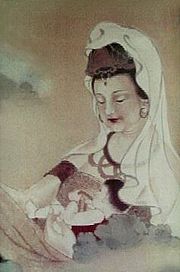Lady Linshui Temple
Lady Linshui Temple in Tainan. This Goddess is believed to protect fetuses and small babies.
http://photos.taiwan-guide.org/index.php/tainan-temples/lady-linshui-temple
Lady Linshui
Lady Linshui (Chen Jing-gu)
Provided by National Museum of Taiwan History
Temple of Lady Linshui
Photo by Huang Xianjin. Provided by Wordpedia.com
Lady Linshui is worshipped in Fujian (福建)
province in China as the patron goddess of women and children. She is
also known, among other names, as “Chen Jinggu (陳靖姑),” “Great Lady,”
“Shunyi furen (順懿夫人, Lady of Good Virtue)” and “Shuntian shengmu (順天聖母,
Holy Mother Who Follows the Will of Heaven).” She is also, together with
the “Second Mother Lady Lin (二媽林夫人)” and the “Third Mother Lady Li
(三媽李夫人),” one of the “Sannai furen (三奶夫人, Three Ladies).” Gazetteers and
legends from the Ming (明) Dynasty (1368–1644) and Qing (清) Dynasty
(1644–1912) tell us that Lady Linshui lived during the Dali (大曆) period
(766–779) of the Tang (唐) Dynasty (766–779) and that she followed the
Daoist teachings of the Xu Xun’s (許遜) Lushan Sect (閭山派), learning their
magical arts. She possessed the ability to exorcise demons and to drive
out evil spirits; “Killing the white snake” and “gathering the demons”
are counted among her legendary achievements. Later, Lady Linshui
rescued Fujian from a long lasting drought by giving birth while praying
for rain and thereby conjuring rain. However, she was not careful and
Changkeng ghost (長坑鬼) and other demons saw what she was up to. They took
on human shape and made their way to her family’s mansion. There they
grabbed and devoured Lady Linshui’s baby. This at once killed Lady
Linshui, who was in the middle of her conjuration. She bled to death
aged just twenty-four as her baby was eaten. As Lady Linshui died, in
the throes of difficult labor, she proclaimed: “After my death, I will
save women in difficult labor or otherwise I will not be a
goddess.”Thereafter, she was worshipped as patron goddess of pregnancy,
easing labor, raising children and expelling demons. In temples and
shrines the likenesses of the goddess are usually displayed in a seated
position and placed in a prominent position. Sometimes she is portrayed
holding a child, but in some temples she can also be found on murals and
landscape art in a prominent position, seated, wearing the robes of a
Daoist priest, holding a sword in hand, recalling her legendary killing
of the demonic snake. These two images show her dual nature, warm and
gentle, but also hard and martial.
The earliest accounts of worship of Lady Linshu can be found in Zhang Yining’s (張以寧)Yuan (元) Dynasty (1271–1368) text Shunyi Temple Inscription
(順懿廟記). The text recounts how the Song (宋) Dynasty county magistrate
Hong Tianxi (洪天錫) erected a memorial tablet to the goddess, showing that
worship of Lady Linshui dates back to the Song Dynasty. In Taiwan
worship of Lady Linshui began with the immigrant society under Qing
rule. According to Taiwanese gazetteers and historical documents the
first temple was the Linshui Temple in Baihe (白河) Township in Tainan
(臺南) County. According to an inscription on a stone stele at the side of
the temple dates from the first year of Emperor Yongzheng’s (雍正) reign
(1723).
The birthday of the goddess Lady Linshui is the 15th day of the 1st
month of the Chinese lunar calendar, that of Lady Lin is the 15th day of
the 8th month and Lady Li’s birthday is the 9th day of the 9th. The
most significant ritual activities related to the Three Ladies take
place on these dates and various temples, such as the Fenxiang (分香)
Temples, Fenling (分靈) Temples, Jiaotou Temples (角頭廟) and the local
temples of the interacting boundaries (交陪境) all participate. The
activities to promote fellowship between the various temples and their
deities reveal much of the power structures between local temples.
Rituals to protect children from demons, fertility rituals (栽花換斗), the
coming of age ceremony for sixteen year-olds (做十六歲) and adopting sons
are all ceremonial activities that commonly take place in these temples.
Copyright © 2011 Council for Cultural Affairs. All Rights Reserved.
Chinese Keyword
English Keyword
References
- He, Qiaoyuan. (1995). Min shu, Vol.1-5 [閩書(五冊)]. Ba min wen xian cong kan. Fuzhou: Fujian People's Publishing House.
- Huang, Zhongzhao. (Ed.). (1991). Ba min tong zhi, Vol.1-2 [八閩通志(兩冊)]. Fu jian di fang zhi cong kan. Fuzhou: Fujian People's Publishing House.
- Lin, Xianji., et al. (1967). Gu tian xian zhi [古田縣志]. Zhong guo fang zhi cong shu, No. 100. Taipei: Cheng Wen Publishing Co., Ltd.
- He, Qiuzuan. (1987). Min dou bie ji, Vol.1-3 [閩都別記(三冊)]. Fuzhou: Fujian People's Publishing House.
- Xie, Jinluan. (Ed.). (1977). Xu xiu tai wan xian zhi [續修臺灣縣志]. Tai wan wen xian shi liao cong kan di er ji, No. 32. Taipei: Datong Bookstore.
Lady Linshui
Classification:Religion > Worship and Religion > Orthodox Deities > Lady Linshui
臨水夫人
Contributor: Kang Shihyu
http://taiwanpedia.culture.tw/en/content?ID=4428




No comments:
Post a Comment